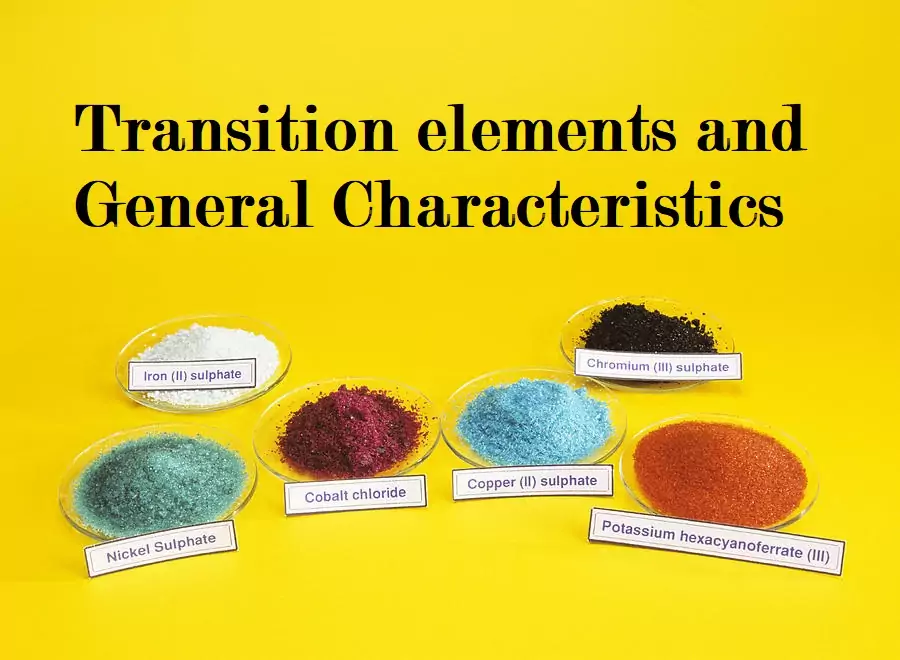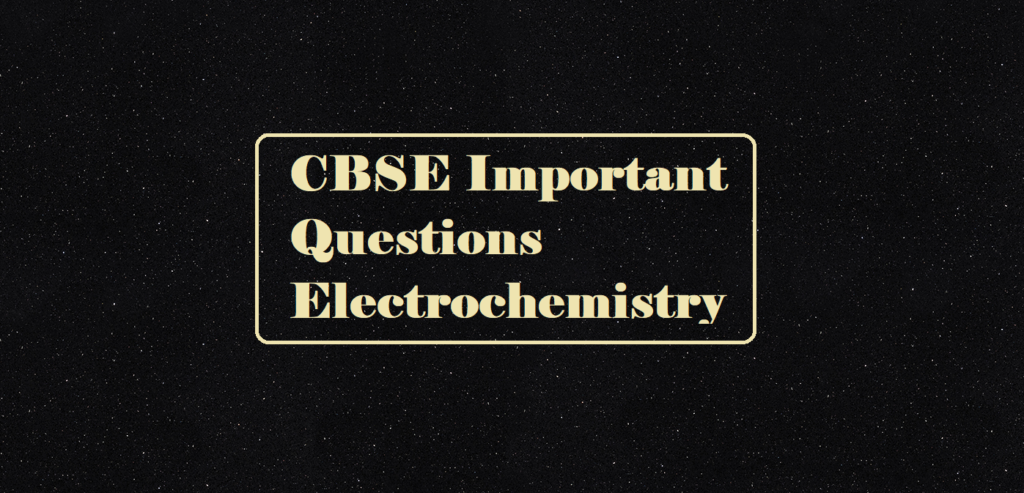Transition elements and General Characteristics
Transition elements and General Characteristics:
Introduction
The elements lying in the middle of periodic table belonging to groups 3 to 12 are known as d – block elements.
The elements in which the last electron enters into the d-orbitals of penultimate shell i.e. (n–1) d where n is the last shell are called d-block elements.
They are placed in between s-block and p-block elements.
They show a regular transition from the highly electropositive metals of s-block elements to the less electropositive p-block elements. So, they are called transition elements.
Transition elements
A transition element is defined as the one which has incompletely filled d orbitals in its ground state or in any one of its oxidation states.
Zinc, cadmium, mercury are not regarded as transition metals due to completely filled d – orbitals in both atomic and ionic state.
The four series of transition element are:-
First transition series → Sc21 to Zn30
Second transition series → Y39 to Cd48
Third transition series → La57, Hf72 to Hg80
Fourth transition series → Ac89, Rf104 onwards (incomplete)
Electronic configuration: General outer electronic configuration of d-block elements is (n-1) d1-10 ns1-2. There is only a small difference in energy between (n-1)d orbital and ns orbital. So in some cases ns electrons are also transferred to (n-1)d level. The electronic configurations of Cr and Cu in the 3d series show some exceptions.
24Cr – [Ar] 3d5 4s1
29Cu – [Ar] 3d10 4s1
This is due to the extra stability of half-filled and completely-filled electronic configurations. (d5 or d10).
General Characteristics of transition element:
(1) Atomic Radii: The atomic radii decrease from Sc to Cr because the effective nuclear charge increases. The atomic size of Fe, Co, Ni is almost the same because the attraction due to the increase in nuclear charge is cancelled by the repulsion because of an increase in shielding effect. Cu and Zn have a bigger size because of the shielding effect increases and electron-electron repulsions repulsion increases. 
(2) Ionic Radii: The atomic and ionic radii of 2nd and 3rd row transition metals are quite similar. This is due to the Lanthanoid contraction. In between the 2nd and 3rd row transition elements, 4f electrons are present. The 4f electrons have very poor shielding effect and as a result the atomic and ionic radii of Lanthanoid decrease from left to right (Lanthanoid contraction).
(3) Melting and Boiling Points: The transition metals have very high m.p. and b.p. The high melting points of these metals are attributed to the involvement of a greater number of the electron from (n-1)d in addition to the ns electrons. This can also be explained in terms of metallic bond strength which depends on the number of unpaired electrons. As the number of unpaired electron increases, the metallic bond strength increases. Hence the melting point also increases. In a given transition series, the number of unpaired electrons increases up to the middle and then decreases. Another factor which affects the m.p is the heat of atomization. Mn and Tc have a low melting point even though they have d5 configuration. This is because of their low heat of atomization. 
(4) Ionisation Enthalpy: There is slight and irregular variation in ionization energies of transition metals due to irregular variation of atomic size. The I.E. of 5d transition series is higher than 3d and 4d transition series because of Lanthanoid Contraction. 
| Lanthanoid Contraction: The steady decrease in the atomic and ionic radii of the transition metals as the atomic number increases. This is because of the filling of 4f orbitals before the 5d orbitals. This contraction is size is quite regular. This is called the lanthanoid contraction. It is because of lanthanoid contraction that the atomic radii of the second row of transition elements are almost similar to those of the third row of transition elements. |
(5) Metallic Character: All transition elements are metallic in nature, i.e. they have strong metallic bonds. This is because of the presence of unpaired electrons. This gives rise to properties like high density, high enthalpies of atomization, and high melting and boiling points.
(6) Oxidation State: Transition metals show variable oxidation states. This is because in these elements d and s electrons have comparable energies. So, in chemical reaction along with s-electrons, d-electrons also participate. In a given transition series, the maximum oxidation state increases up to the middle and then decreases.
The most common oxidation states are in circles
(7) Electrode Potential: The electrode potential values of first-row transition series generally increases from left to right with some exceptions. The E0(Cu2+/Cu) is positive (+0.34V), while the E0 values of all the other first-row transition elements are –ve. This is because the high energy required to transform Cu(s) to Cu2+(aq) is not balanced by its hydration enthalpy. So, Cu does not easily react with acid and liberate H2. Only oxidizing acids [HNO3 and hot Conc. H2SO4] react with Cu and the acid get reduced. 
(8) Magnetic properties Paramagnetic: Due to the presence of the unpaired electrons in (n-1)d orbitals, most of the transition metal ions and their compounds are paramagnetic. They are attracted by the magnetic field. Diamagnetic – They have paired electrons and are repelled by a magnetic field.
Magnetic moment µs = √n(n+2), n = number of unpaired electrons Magnetic moment or paramagnetic property increases with an increase in the number of unpaired electrons. Ferromagnetic – Substance which is attracted very strongly is said to be ferromagnetic. Ferromagnetism is an extreme form of paramagnetism.
Enthalpy of atomisation, ΔaH0, is the change in enthalpy when one mole of bonds are completely broken to obtain atoms in the gas phase.
(9) Enthalpy of Atomization: Transition elements (except Zn, Cd and Hg) are much harder and less volatile. They exhibit high enthalpies of atomization. The maximum value lies at about middle of each series indicating the interatomic interaction increases with the number of unpaired d-electrons. The metals of 4d and 5d transition series have greater enthalpies of atomization than the corresponding elements of the first (3d) series. This is due to much more frequent metal-metal bonding in their compounds. 
(10) Formation of Coloured Compounds: They form coloured ions due to the presence of partially filled d – orbitals and unpaired electrons, they can undergo d – d When an electron from a lower energy d orbital is excited to a higher d level, it absorbs energy and this is equal to the energy of certain colours in the visible region. So, the colour observed is the complementary colour of the light absorbed. 
(11) Formation of complexes: Transition metals form complexes due to, Presence of vacant d – orbitals of suitable energy, Smaller size, the Higher charge on cations, Ability to show a variable oxidation state. Eg: K4[Fe(CN)6], K3[Fe(CN)6], [Ni(CO)4] etc.
(12) Catalytic Properties: Most of the transition metals are used as catalyst because of the presence of incomplete or empty d – orbitals, Large surface area, Variable oxidation state, Ability to form complexes E.g., Fe, Ni, V2O3, Pt, Mo, Co and used as a catalyst.
(13) Interstitial Compounds: Transition metals have empty spaces or interstitial sites in which non-metals C, H, N, B etc. can fit into resulting in the formation of interstitial compounds. They are non – stoichiometric, i.e., their composition is not fixed, e.g., steel. They are harder and less malleable and ductile E.g.: Fe3H, Mn4N, TiC, VH56, TiH1.7 etc. Some of the properties of these compounds are: They have a high melting point, They are very hard, They retain metallic conductivity, They are chemically inert. 
(14) Alloy Formation: Alloys are homogeneous solid solutions of elements in which at least one element is a metal. They are formed by atoms with metallic radii within about 15% of each other. Because of similar radii and other characteristics of Transition metals, they readily form alloys. The alloys formed are hard and have high m.p. e.g.: Bronze (Cu, Zn), Stainless steel (Fe, C, Ni, Mn and Cr). 
Transition elements and General Characteristics






